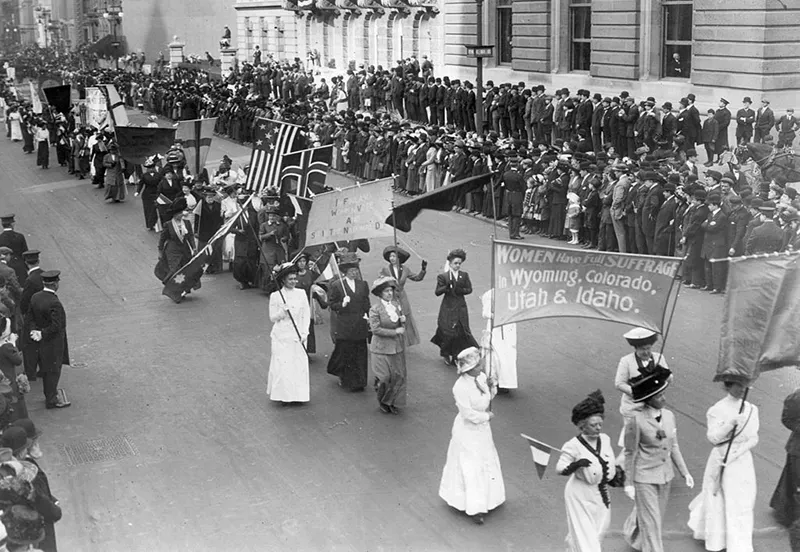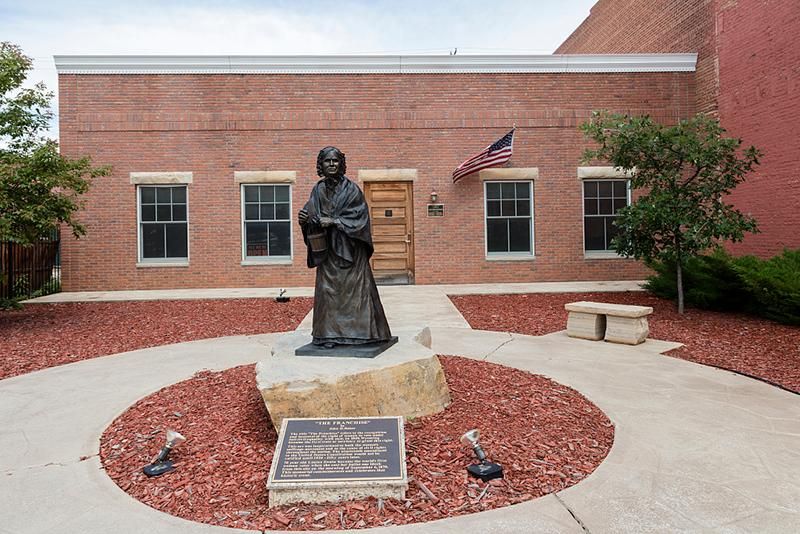Women Have Been Voting in Wyoming for 150 Years, and Here Is How the State Is Celebrating
To mark the anniversary, Wyoming is delivering an impressive lineup of events, from a reenactment of the first vote to female-focused exhibits and retreats
:focal(477x170:478x171)/https://tf-cmsv2-smithsonianmag-media.s3.amazonaws.com/filer/f4/57/f457bc04-93c8-4287-8dc8-2d32e2192901/wyoming_women_voting_bhp_images.jpg)
In 1870, a full 50 years before the 19th amendment gave women the right to vote in the United States, Louisa Swain cast a historic ballot for the general election in Laramie, Wyoming. She was voting thanks to a law passed the year before in the Territory of Wyoming, giving women over the age of 21 the right to vote and to hold public office.
"Voters had to be a citizen or swear an oath that they were seeking citizenship," says Kim Viner, a docent at the Laramie Plains Museum, which meant that the right did not extend to Native Americans and Chinese immigrants, who were excluded from citizenship at the time. Black women, officially, were able to vote under the law, but it's unknown if any did. "In Laramie there were only three black women in a population of just under 800," Viner says. "The Laramie [news]paper did note that 93 women voted in 1870 but did not mention any names other than Louisa Swain."
As such, Swain became the first woman to legally vote at the same level as a man in the United States. The territories of Utah (1870), Washington (1883) and Montana (1887) would follow, and, in 1890, when Wyoming was admitted to the Union, its state constitution granted women voting rights. In 1893, Colorado became the first state to pass women's suffrage into law through a referendum.

The whole act in Wyoming wasn't necessarily motivated by women's rights, though. Viner says one of the main reasons Wyoming territorial legislator William Bright introduced the bill was because he opposed giving black men the right to vote. Bright thought if they could vote, his wife should be able to as well. It was passed under similar specious intentions: there were those who wanted to increase the population of the territory enough to allow for statehood and to bring in more women so men would have someone to marry, and Democrats who wanted the Republican governor to veto the bill and thereby put him and his party in a bad light. Luckily, some of the officials actually thought it was the right thing to do, too.
We may never actually know, though, the real motivations behind women winning the vote. "No records were kept of the debate between Wyoming territorial lawmakers, although individuals likely asserted a myriad of motivations and intentions in supporting women's suffrage," says Wyoming Senator Affie Ellis. She also notes that the Native Americans in the region probably had an influence on the suffrage law. "Several tribes were (and are) matriarchal societies where women held the primary power positions in political leadership, moral authority, social privilege and control of property," she says. "Navajos, for example, trace descent through the mother. There is no doubt in my mind that matriarchal Indian Nations influenced suffrage to some degree."
Regardless, Wyoming has long placed great importance on women's rights. Among other major breakthroughs such as voting rights, the state was the first to allow women to own property and sign legal documents. In 1870, Esther Hobart Morris became the first female justice of the peace, serving in South Pass City, Wyoming. That year in Wyoming also saw the country’s first all-female jury, and the first woman bailiff in the world, Martha Symon Boies. Later, in 1894, Estelle Reel Meyer became Superintendent of Public Instruction, the country’s first female statewide elected official. From 1920 to 1921, Jackson, Wyoming, was the first town in the U.S. governed completely by women. And from 1925 to 1927, following her husband’s death, Nellie Tayloe Ross served as the country’s first woman governor. She set another record in 1933 when she became the first female head of the U.S. Mint, a role she held for 20 years. In 1889, Wyoming vied for statehood—and refused to join the union if the laws giving equality to women were not upheld, telling Congress (which wanted the suffrage law rescinded) via telegram, “We will remain out of the Union 100 years rather than come in without the women.”
To celebrate 150 years of women's suffrage in Wyoming, and the many great women of the state's past, present and future, a slate of events and retreats is planned throughout the year and into 2020.
Reopening of the Wyoming Capitol
After a multi-year renovation, the renaissance revival-style Wyoming Capitol Building in Cheyenne is expected to reopen mid-2019, just in time for the women’s suffrage anniversary in the state. The building, which was inspired and influenced by the construction style of the Virginia State Capitol, was constructed in 1888 and is one of only 20 state capitols registered as a national historic landmark, thanks specifically to its place in the history of women's suffrage. After the renovation is complete, visitors will be able to tour the Territorial House Chamber, where the women’s suffrage law was upheld when Wyoming wanted to enter the Union. The room, originally an open two-story space, was once converted into two floors—the restoration will bring back the open area, and return stained glass and an original chandelier to the chamber.
First Vote Reenactment at the Wyoming House for Historic Women
On September 6, join The Louisa Swain Foundation for the annual reenactment of Swain’s historic first vote. Each year, a local woman portrays Swain, depositing her vote in the ballot box. City officials in Laramie follow it with speeches and talks about suffrage. In the past, the reenactment has coincided with voter registration drives. In between reenactments, the foundation offers educational programs on suffrage, democracy and human rights. This event will be held at the Wyoming House for Historic Women, a downtown Laramie museum paying tribute to 13 of the most influential women in Wyoming’s history—including Swain, Eliza Stewart (the first female jury member), Martha Symons Boies (the world's first woman bailiff), Esther Hobart Morris (the first woman in the world to hold judicial office) and Nellie Tayloe Ross (the first female governer in the U.S. and the first woman director at the U.S. Mint). A life-sized bronze sculpture of Swain with her ballot, created by local sculptor John Baker, welcomes visitors. This year’s event will be geared toward a celebration of Wyoming’s suffrage history, complete with visual displays discussing women's history in the state.

Proud Wyoming Woman Retreat, Sept. 13 – 15
For the second year, this retreat will honor the women of Wyoming and their journey from suffrage in 1869 forward. Jenissa Meredith, executive director of Sweetwater County Travel and Tourism, founded the retreat, the goal being, she told Sweetwater Now, to "reflect the pride that originated at the time of women’s suffrage and that lives on today." More than 50 women attended the first retreat. This year, the agenda includes networking, arts and culture, and female health and wellness activities. Displays and education sessions will help pay homage to the historical women that helped to make the state what it is today.
"Women in Wyoming," Buffalo Bill Center of the West; October 25, 2019 to August 2, 2020
Women take over the Buffalo Bill Center of the West, a network of five museums and a research library devoted to art and artifacts of the American West in Cody, starting this October, with the launch of the exhibit, "Women in Wyoming." The exhibit features large-scale portraits, audio soundscapes and interactive elements created by artist, photographer and Wyoming native Lindsay Linton Buk. In her efforts to capture contemporary trailblazing women in the state, from ranchers like Mickey Thoman to artists such as Neltje, Buk logged more than 15,000 miles, 600 rolls of film and 3,000 minutes of recordings.
“The timing with 'Women in Wyoming' and the 150th anniversary of Wyoming giving women the right to vote is incredible,” said Buk, in a release from the center. “In a state as rural as Wyoming, we’re often isolated, so it’s vital to be able to see your peers and the important work they’re doing. 'Women in Wyoming' is important now because it gives women strong examples to look up to and show the many pathways to success in the rural West today.”
“Year of the Woman” at the Nicolaysen “Nic” Art Museum
Beginning January 1, 2020, Casper's 25,000-square-foot Nicolaysen Art Museum (focusing on contemporary arts in the Rocky Mountain region) will host a year of exhibits dedicated to women. There will be three rotations of art created by 10 female artists, including Ginny Butcher, Betsey Bower, Karen Hennick, Aubry Ellis and Molly Box, in a pop-up gallery space on the third floor of the museum. The museum's curator, Amanda Yonker, specifically sought out women artists who encapsulate a large variety of artistic styles, including installation art, ceramics, abstract expressionism, reverse painting on found objects, metal work, pastel and textile art.
The Nic is especially meaningful to women's history in Wyoming because women founded it in 1967, and women still comprise the bulk of the board and executive positions. Its original mission was to bring in art from around the world so locals wouldn't have to travel far to see it—now, the Nic focuses on being one of the only spaces where local artists have work on display.
/https://tf-cmsv2-smithsonianmag-media.s3.amazonaws.com/accounts/headshot/JenniferBillock.png)
/https://tf-cmsv2-smithsonianmag-media.s3.amazonaws.com/accounts/headshot/JenniferBillock.png)